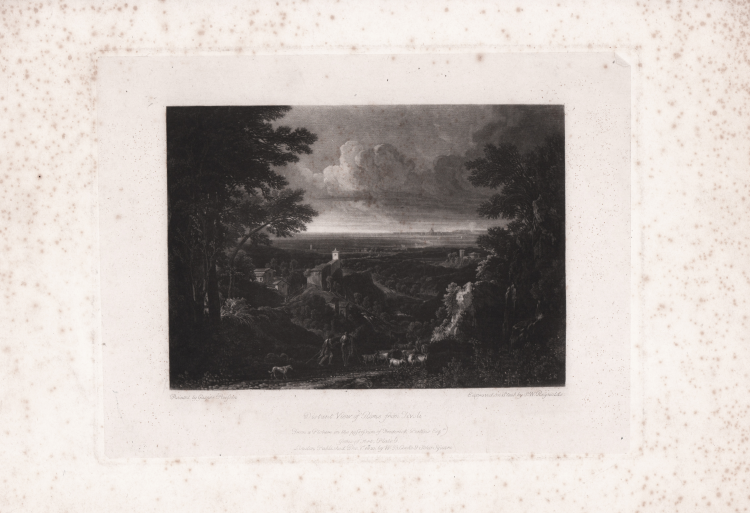




| Reference: | S46630 |
| Author | Samuel William I Reynolds |
| Year: | 1823 |
| Zone: | Rome |
| Printed: | London |
| Measures: | 270 x 205 mm |



| Reference: | S46630 |
| Author | Samuel William I Reynolds |
| Year: | 1823 |
| Zone: | Rome |
| Printed: | London |
| Measures: | 270 x 205 mm |
Landscape, with goats and goatherds walking downhill in the foreground and city in the far distance; after Gaspar Dughet.
Mezzotint, 1823, lettered below image with production details: "Painted by Gasper Poussin / Engraved on Steel by S.W. Reynolds. / Engraver to the King / London, Published Decr. 1. 1823, by W.B. Cooke, 9 Soho Square.", the title, information about the owner of the painting, and "Gems of Art Plate 9.".
Very good impression of second state, printed on "chine" paper, some signs of foxing on white margins, otherwise good condition.
Bibliografia
Whitman 1903, Nineteenth Century Mezzotinters: Samuel William Reynolds (428a.II).
Samuel William I Reynolds (1773-1835)
|
Samuel William Reynolds (July 4, 1773 - August 13, 1835) was a mezzotint engraver, landscape painter and landscape gardener. Reynolds was a very popular engraver in both Britain and France; more than 400 examples of his work are preserved at the National Portrait Gallery in London. Reynolds was born on July 4, 1773. Reynolds studied in the Royal Academy schools and under mezzotint engravers Charles Howard Hodges and John Raphael Smith. His first dated mezzotint is a portrait of George, Prince of Wales, dated May 1794. He also engraved a large number of portraits and compositions of Dance, Jackson, William Owen (1769-1825), Stephanoff, Bonington, Gregor MacGregor, Sir Robert Ker Porter and others, and was one of the artists employed by J. M. W. Turner for his Liber Studiorum. Reynolds worked with great rapidity, often combining the techniques of etching, aquatint and drypoint etching with mezzotint. Throughout his career he practiced oil and watercolor painting and exhibited landscapes and other subjects at the Royal Academy and the British Institution beginning in 1797. His highly original and striking landscapes were exhibited mainly in France and Germany, which explains the painter's lack of notoriety in Britain. In 1809 Reynolds went to Paris for the first time, and in 1810 and 1812 he exhibited etchings at the Salon. Between 1820 and 1826 he published a series of 357 small plates in four volumes, reproducing all the then accessible works of Sir Joshua Reynolds, with whom he claimed a relationship. At the end of this series he again went to Paris, where his work, both in painting and engraving, aroused great enthusiasm among French artists, many of whom became his pupils. An article that appeared at the time in L'Artiste, describing Reynolds' extraordinary talent, is quoted by Beraldi in Les Graveurs du XIXe Siècle. Reynolds had many pupils, the most skilled of whom were Samuel Cousins, David Lucas and John Lucas (1807-1874). He was also a skilled landscaper and created the gardens at Southall and Mount Edgcumbe. He died of paralysis at Ivy Cottage, Bayswater, London, where he had lived for many years, on August 13, 1835. His collections, which consisted mainly of drawings and engravings owned by him, were sold by Christie's the following April.
|
Samuel William I Reynolds (1773-1835)
|
Samuel William Reynolds (July 4, 1773 - August 13, 1835) was a mezzotint engraver, landscape painter and landscape gardener. Reynolds was a very popular engraver in both Britain and France; more than 400 examples of his work are preserved at the National Portrait Gallery in London. Reynolds was born on July 4, 1773. Reynolds studied in the Royal Academy schools and under mezzotint engravers Charles Howard Hodges and John Raphael Smith. His first dated mezzotint is a portrait of George, Prince of Wales, dated May 1794. He also engraved a large number of portraits and compositions of Dance, Jackson, William Owen (1769-1825), Stephanoff, Bonington, Gregor MacGregor, Sir Robert Ker Porter and others, and was one of the artists employed by J. M. W. Turner for his Liber Studiorum. Reynolds worked with great rapidity, often combining the techniques of etching, aquatint and drypoint etching with mezzotint. Throughout his career he practiced oil and watercolor painting and exhibited landscapes and other subjects at the Royal Academy and the British Institution beginning in 1797. His highly original and striking landscapes were exhibited mainly in France and Germany, which explains the painter's lack of notoriety in Britain. In 1809 Reynolds went to Paris for the first time, and in 1810 and 1812 he exhibited etchings at the Salon. Between 1820 and 1826 he published a series of 357 small plates in four volumes, reproducing all the then accessible works of Sir Joshua Reynolds, with whom he claimed a relationship. At the end of this series he again went to Paris, where his work, both in painting and engraving, aroused great enthusiasm among French artists, many of whom became his pupils. An article that appeared at the time in L'Artiste, describing Reynolds' extraordinary talent, is quoted by Beraldi in Les Graveurs du XIXe Siècle. Reynolds had many pupils, the most skilled of whom were Samuel Cousins, David Lucas and John Lucas (1807-1874). He was also a skilled landscaper and created the gardens at Southall and Mount Edgcumbe. He died of paralysis at Ivy Cottage, Bayswater, London, where he had lived for many years, on August 13, 1835. His collections, which consisted mainly of drawings and engravings owned by him, were sold by Christie's the following April.
|